Building an organized online art portfolio is essential for artists. It doesn’t matter if you’re showcasing a few signature pieces or a full gallery of collections. Setting up a clear taxonomy is crucial. Thoughtful categories also help viewers find their way through your work. Descriptive tags boost searchability and accessibility. Here’s a guide to setting up an efficient art “map.” This will make navigating your portfolio easy. It will also make it engaging for visitors.

1. Start with Taxonomy: The Blueprint of Your Art Portfolio
Think of taxonomy as the big-picture layout of your entire site, much like the blueprint of an art gallery. This step is about planning how you’ll organize everything, considering the broad groups and subgroups where your artwork fit.
Common Art Taxonomy Levels:
- Main Categories: This is your top level, based on broad themes or formats. For example:
- Medium: Paintings, Digital Art, Photography, Sculpture, Mixed Media
- Genre: Abstract, Fantasy, Realism, Portraits, Landscapes
- Collections or Series: Seasons, Dreams, Reflections, Castles in the Clouds (or other specific series names)
- Subcategories: These are more specific groups within each main category. For example, under “Photography,” you have:
- Black & White Photography
- Portrait Photography
- Nature Photography
This layered structure makes it easy for visitors to find work that matches their interests. It also gives your site a logical flow.
2. Choosing Categories: Defining Your Art’s Broad Themes
Once you have mapped out your taxonomy, it’s time to decide on categories. Categories represent the main buckets that contain your work. Choose categories that capture the essence of your pieces and appeal to the way visitors look for art.
Examples of Art Categories:
- By Medium: Painting, Digital Art, Sculpture, Printmaking
- By Topic Matter: Landscapes, Portraits, Animals, Fantasy
- By Style: Surrealism, Impressionism, Abstract, Realism
- By Color Theme: Monochrome, Pastels, Vibrant Colors, Earth Tones
Tips for Effective Categories:
- Keep it Simple: Avoid too many top-level categories, or you risk overwhelming visitors.
- Use Recognizable Terms: Think about how your audience would describe the work. You may consider your piece as “Futuristic Portraiture.” Yet, a simpler “Portrait” or “Digital Portrait” will better connect with the audience.
- Stick to 5–10 Main Categories: This keeps your site easy to navigate. You can always expand later if needed.
3. Using Tags: Adding Detail and Searchability
Tags add specificity to each piece of art within your categories. They’re like keywords that give more context, allowing viewers to find art based on themes, colors, moods, and other characteristics.
Examples of Effective Art Tags:
- Techniques: Oil on Canvas, Watercolor, Pencil Sketch, Digital Painting
- Subjects or Motifs: Castles, Flowers, Dreams, Architecture, Fantasy Creatures
- Color Palette: Blue, Earthy Tones, Black and White, Bold Colors
- Themes: Minimalism, Urban Life, Mythology, Wilderness, Dreamscapes
- Moods: Serene, Dramatic, Playful, Dark, Whimsical
Tagging Tips:
- Use Specific Descriptors: Avoid vague tags like “Nice” or “Cool.” Instead, go for terms that give insights, like “Pastel Landscape” or “Whimsical Creature.”
- Avoid Redundancy: Don’t tag every piece with “Art” or “Artwork”—that’s implied! Instead, focus on what makes each piece unique.
- Limit Tags to 3-5: This gives you enough detail without overwhelming users with too many choices.
4. How to Create Your Own Art Map
To get your taxonomy, categories, and tags organized, try this simple step-by-step process:
Step 1: Brainstorm and List Your Artwork’s Themes
Create a list of key themes, styles, subjects, colors, and techniques that your art covers. Then group these into broad themes for your main categories.
Step 2: Create a Draft of Your Taxonomy
Draft an outline of your categories and subcategories. For example:
- Digital Art
- Abstract
- Realism
- Fantasy
- Photography
- Nature
- Black & White
- Portraits
Step 3: Add Tags to Each Piece
After categorizing, go back through individual pieces and add specific tags. List out the color palette, topic matter, technique, and mood for each piece, and add tags based on this list.
Step 4: Test the Navigation Flow
Ask a friend to explore the site. Do they get lost, or can they easily find what they’re looking for? This is a great way to test if your taxonomy and categories make sense to someone unfamiliar with your work.

Step 5: Make Adjustments Based on Feedback
Sometimes it takes a fresh set of eyes to reveal what works and what does not. If categories or tags seem confusing, revise them to make sure they’re clear and easy to navigate.
5. Examples of Art Map Structures
Here are a few sample structures to get you started:
- Example 1: For a general portfolio
- Taxonomy: Medium
- Categories: Digital Art, Photography, Sculpture, Mixed Media
- Tags: “Nature,” “Cityscapes,” “Earthy Tones,” “Dreamy,” “Minimalist”
- Example 2: For a fantasy-themed gallery
- Taxonomy: Topic and Style
- Categories: Surrealism, Mythology, Space Fantasy, Nature Fantasy
- Tags: “Fairies,” “Castles,” “Dark Woods,” “Intergalactic,” “Mystical”
- Example 3: For a color-driven artist
- Taxonomy: Color Themes
- Categories: Pastels, Bold Colors, Monochrome
- Tags: “Vibrant Blue,” “Soothing Green,” “Neon Pop,” “Earthy Browns,” “Minimalism”
Final Thoughts
Creating a structured “art map” with taxonomy, categories, and tags is a powerful way to show your portfolio. It makes it easier for visitors to explore your work. It also shows off your range, themes, and style. This organized presentation enhances both searchability and professionalism.
Plan and map things out thoughtfully. You’ll save yourself hours of organization down the line. This ensures your art shines in its best possible light. So, take the time to map it out, and watch your portfolio flourish!



